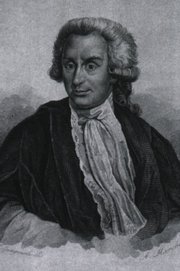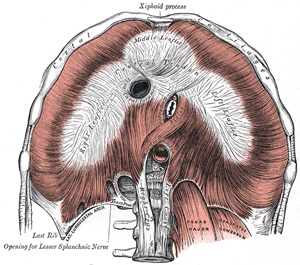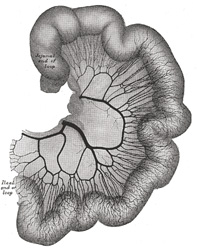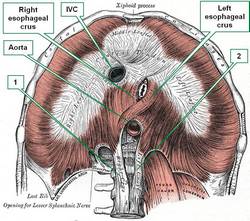
Medical Terminology Daily (MTD) is a blog sponsored by Clinical Anatomy Associates, Inc. as a service to the medical community. We post anatomical, medical or surgical terms, their meaning and usage, as well as biographical notes on anatomists, surgeons, and researchers through the ages. Be warned that some of the images used depict human anatomical specimens.
You are welcome to submit questions and suggestions using our "Contact Us" form. The information on this blog follows the terms on our "Privacy and Security Statement" and cannot be construed as medical guidance or instructions for treatment.
We have 851 guests online

Georg Eduard Von Rindfleisch
(1836 – 1908)
German pathologist and histologist of Bavarian nobility ancestry. Rindfleisch studied medicine in Würzburg, Berlin, and Heidelberg, earning his MD in 1859 with the thesis “De Vasorum Genesi” (on the generation of vessels) under the tutelage of Rudolf Virchow (1821 - 1902). He then continued as a assistant to Virchow in a newly founded institute in Berlin. He then moved to Breslau in 1861 as an assistant to Rudolf Heidenhain (1834–1897), becoming a professor of pathological anatomy. In 1865 he became full professor in Bonn and in 1874 in Würzburg, where a new pathological institute was built according to his design (completed in 1878), where he worked until his retirement in 1906.
He was the first to describe the inflammatory background of multiple sclerosis in 1863, when he noted that demyelinated lesions have in their center small vessels that are surrounded by a leukocyte inflammatory infiltrate.
After extensive investigations, he suspected an infectious origin of tuberculosis - even before Robert Koch's detection of the tuberculosis bacillus in 1892. Rindfleisch 's special achievement is the description of the morphologically conspicuous macrophages in typhoid inflammation. His distinction between myocardial infarction and myocarditis in 1890 is also of lasting importance.
Associated eponyms
"Rindfleisch's folds": Usually a single semilunar fold of the serous surface of the pericardium around the origin of the aorta. Also known as the plica semilunaris aortæ.
"Rindfleisch's cells": Historical (and obsolete) name for eosinophilic leukocytes.
Personal note: G. Rindfleisch’s book “Traité D' Histologie Pathologique” 2nd edition (1873) is now part of my library. This book was translated from German to French by Dr. Frédéric Gross (1844-1927) , Associate Professor of the Medicine Faculty in Nancy, France. The book is dedicated to Dr. Theodore Billroth (1829-1894), an important surgeon whose pioneering work on subtotal gastrectomies paved the way for today’s robotic bariatric surgery. Dr. Miranda.
Sources:
1. "Stedmans Medical Eponyms" Forbis, P.; Bartolucci, SL; 1998 Williams and Wilkins
2. "Rindfleisch, Georg Eduard von (bayerischer Adel?)" Deutsche Biographie
3. "The pathology of multiple sclerosis and its evolution" Lassmann H. (1999) Philos Trans R Soc Lond B Biol Sci. 354 (1390): 1635–40.
4. “Traité D' Histologie Pathologique” G.E.
Rindfleisch 2nd Ed (1873) Ballieres et Fils. Paris, Translated by F Gross
"Clinical Anatomy Associates, Inc., and the contributors of "Medical Terminology Daily" wish to thank all individuals who donate their bodies and tissues for the advancement of education and research”.
Click here for more information
- Details

Original image courtesy of Wikipedia.org
An esophageal hiatus hernia (also known as a hiatal hernia) eventually may require surgery. In this case, the objective is three-fold: To bring the abdominal viscera to its proper intraabdominal position (reduction) , to create a pseudovalve to prevent gastroesophageal reflux, and to prevent a recurrence of the herniation.
There have been different procedures developed to this effect. One of the most popular has been the Nissen fundoplication either trough the open surgery approach or by way of a minimally invasive laparoscopic procedure.
This procedure was pioneered by Dr. Rudolf Nissen (1896 - 1981) in 1955. After reducing the hiatal hernia and repairing the dilated esophageal hiatus, the surgeon creates a gastric wrap around the abdominal esophagus by bringing the fundus of the stomach through a retroesophageal passage, and suturing the fundus to the stomach. (see image). One of the concerns of the procedure is the ligation and transection of the short gastric vessels that pass within the gastrosplenic ligament to allow greater mobility of the gastric fundus and prevent potential avulsion of the short gastric vessels.
Since the introduction of this open procedure in 1955 there have been several variations, such as the "Nissen-Rosetti" procedure, a "loose" fundoplication; the "Toupet" procedure, an "incomplete" fundic wrap, and others, including laparoscopic procedures.
The advent of NOTES (Natural Orifice Transluminal Endoscopic Surgery) has brought a new procedure: Transoral Incisionless fundoplication (TIF), where a pseudovalve is created using an endoscope inserted into the esophagus and stomach through the oral cavity without abdominal incisions or trocar ports. For more information on this procedure, click here. Clicking on the inferior image will start a six-minute video of the TIF procedure and the EsophX device.
- Details
The term [hiatus] derives from the Latin word [hiare], meaning to "gape" or to "yawn". In human anatomy this term is used to mean an "opening" or a "defect". It must be pointed out that in anatomy (and surgery) the term "defect" does not necessarily mean "defective". In most cases a "defect" is a normal opening in a structure, such as the esophageal hiatus. The plural form is either [hiatus] or [hiatuses].
There are many hiatuses in the human body, such as:
• Hiatus semilunaris: a crescent-shape opening in the lateral aspect of the nasal wall
• Esophageal hiatus: an opening in the muscular posterior aspect of the respiratory diaphragm, bound by two muscular crura
• Aortic hiatus: an opening in the posterior aspect of the respiratory diaphragm, bound by two tendinous crura
• Hiatus Fallopii: the entrance to the facial canal, an opening in the temporal bone allowing for passage of the facial nerve (CN V). Named after Gabrielle Fallopius
- Details
The respiratory diaphragm is a musculotendinous dome-shaped shelf that divides the thoracic cavity from the abdominal cavity. It is one of the four named diaphragms in human anatomy. This is why it is proper to call it the "respiratory diaphragm" instead of just "diaphragm".
The name comes from the Greek, where the prefix [dia-] means "complete" or "through" and [phragm] means "a partition". In Latin, Celsus called it the "septum transversum", meaning "the transverse partition". The root term for [diaphragm] is [-phren-], as in phrenic nerves and cardiacophrenic vessels.
The respiratory diaphragm has a club-shaped central tendon (as in a card suit) which has a large hiatus for the inferior vena cava. The muscular portion is formed by skeletal (voluntary) muscle and descends skirt-like to attach to the internal aspect of the sternum and ribs anterolaterally, and a complex system of lumbocostal tendinous arches posteriorly.
It receives its blood supply through branches of the intercostal arteries, the musculophrenic artery, and the pericardiacophrenic arteries. It is innervated by the phrenic nerves, which descend through the mediastinum in relation to the pericardium.
The respiratory diaphragm has not one, but seven openings (hiatuses) to allow for passageway of many structures:
- Esophageal hiatus
- Aortic hiatus
- Inferior vena cava hiatus
- Hiatuses (2) for the superior epigastric vessels, which are the inferior continuation of the internal thoracic (mammary) vessels. Also known as the hiatuses of Morgagni.
- Hiatuses (2) for the splanchnic nerves
The most common site for an internal abdominothoracic herniation is the esophageal hiatus, but there are other respiratory diaphragm hernias, including the retrosternal hernia of Morgagni (through the superior epigastric hiatus), and the hernia of Bochdalek (a congenital hernia through an incomplete central tendon of the respiratory diaphragm).
Sources:
1 "Tratado de Anatomia Humana" Testut et Latarjet 8 Ed. 1931 Salvat Editores, Spain
2. "Anatomy of the Human Body" Henry Gray 1918. Philadelphia: Lea & Febiger Image modified by CAA, Inc.
Original image by Henry Vandyke Carter, MD., courtesy of bartleby.com
- Details
The jejunum is an intraperitoneal organ, it is the second portion of the small intestine and part of the digestive tract. It begins at the duodenojejunal junction where it is related to the ligament of Treitz, and extends 8 to 9 feet, continuing distally with the ileum.
Being intraperitoneal, it is anchored to the posterior abdominal wall by the double-layered mesentery through which the jejunum receives its blood and nerve supply. At the root (base) of the mesentery are the superior mesenteric vessels.
The Latin word [jejunis] means "empty" or "fasting". The Latin term [jejunum] was used by the Romans to denote the first meal of the day, breakfast, when you have an "empty" stomach. The term was associated with this segment of the small intestine, as it is most of the time found empty in cadavers being dissected.
There is no clear anatomical boundary between the jejunum and ileum, as they blend smoothly one into the other. There are several gross changes from jejunum to ileum, one of them being that the complexity of the mesenteric arterial arches increases from proximal to distal. See the accompanying image. Click on it for a larger depiction.
Two interesting side notes: In English, the term for the first meal of the day is self-explanatory: [break - fast], adding to the Roman concept of "fasting" or "jejunum". In Spanish, the term for breakfast is [desayuno], where the word [ayuno] means "fasting", therefore the word [des-ayuno] also means "the end of fasting". Look at the evolution (in Spanish) from [jejunum] to [yeyuno] (the Spanish term for the organ) to [ayuno], meaning "fasting" or "empty".
Sources:
1. "The Origin of Medical Terms" Skinner, HA 1970 Hafner Publishing Co.
2. "Clinically Oriented Anatomy" Moore, KL. 3r Ed. Williams & Wilkins 1992
3 "Tratado de Anatomia Humana" Testut et Latarjet 8 Ed. 1931 Salvat Editores, Spain
4. "Anatomy of the Human Body" Henry Gray 1918. Philadelphia: Lea & Febiger Image modified by CAA, Inc.
Original image by Henry Vandyke Carter, MD., courtesy of bartleby.com
- Details
The word [crus] is Latin (cruris) and refers to the leg, or region of the shin. It is commonly used to mean "leg" or "pillar". The plural form is [crura].
Several authors suggest a relation of [crus] with another Latin term [crux] meaning "cross" as if a cross is formed by two [crura] (legs).
The term crus is widely used in human anatomy:
- crus cerebri: there are two crus cerebri in the anterior aspect of the mesencephalon
- crura of the penis: the posterior aspect of the corpora cavernosa firmly attached to the ischiopubic rami
- crura of the clitoris: the posterior aspect of the corpora cavernosa firmly attached to the ischiopubic rami
- crura fornix cerebrii: the posterior converging bands that form the fornix of the cerebrum
Special mention is deserved by the crura of the diaphragm. There are two pairs of diaphragmatic crura. The esophageal crura (right and left) which bound the passageway of the esophagus from the thorax into the abdomen, the esophageal hiatus. The esophageal crura have a muscular structure. The aortic crura (righ and left) allow for passage of the aorta into the abdomen, and although muscular superiorly, they are mostly tendinous. The accompanying image shows an anteroinferior view of the respiratory diaphragm. Click on the image for a larger picture.
Sources:
1. "The Origin of Medical Terms" Skinner, HA 1970 Hafner Publishing Co.
2. "Medical Meanings - A Glossary of Word Origins" Haubrich, WD. ACP Philadelphia
3 "Tratado de Anatomia Humana" Testut et Latarjet 8 Ed. 1931 Salvat Editores, Spain
4. "Anatomy of the Human Body" Henry Gray 1918. Philadelphia: Lea & Febiger
Image modified by CAA, Inc. Original image by Henry Vandyke Carter, MD., courtesy of bartleby.com
- Details
This article is part of the series "A Moment in History" where we honor those who have contributed to the growth of medical knowledge in the areas of anatomy, medicine, surgery, and medical research.

Luigi Galvani
Luigi A. Galvani (1737-1798). Italian anatomist, surgeon, and physiologist, Luigi Aloisio Galvani was born in Bologna in 1737. Although he started his studies to join the church, Galvani followed with medical studies at the University of Bologna, where he became a skilled anatomist and surgeon. On July 15, 1759 Galvani obtained his degree in medicine and philosophy.
He was interested in the effects of electricity on tissues and through observation and experimentation he postulated the existence of "animal electricity", that is, electricity generated within the tissues. He postulated the possibility that nerves carried electricity. His theories led to a passionate controversy with Volta, who denied Galvani's postulates. Galvani's theories would only be confirmed after his death.
Galvani was deeply religious, and when forced by government officials to take an oath of atheism, he refused. He was stripped of his position and was lead to poverty. His position was restored close to his death. In his honor, Andre Ampere (1775-1836) named one of his inventions that measures electricity, the "galvanometer". His name is also present in vernacular English, when we say that a rock star or a movie "galvanizes" an audience, meaning it was "electrifying"!
Sources:
1. "Luigi Galvani" Haas LF J Neurol Neurosurg Psychiatry v.56(10); Oct 1993
2. "Luigi Galvani and the foundations of electrophysiology" Cajavilca C, Varonb,J,Sternbachc GL; Resuscitation 80 (2009) 159–162




